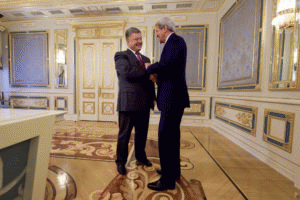Simonovic criticized the SBU for "not always providing access to all places where detainees may be kept. ... OHCHR (the Office of the U.N. High Commissioner on Human Rights) also continues to receive accounts about torture and ill-treatment, arbitrary and incommunicado detention by the SBU, especially in the conflict zone.
"Torture and threats to members of the families, including sexual threats, are never justifiable, and perpetrators will be held to account sooner or later. ... War crimes, crimes against humanity and grave breaches of human rights cannot be the subject of an amnesty."
Yet, the SBU strongly influenced the direction of the JIT, which included Ukraine along with the Netherlands, Belgium, Australia and Malaysia. The JIT agreement gave Ukraine veto power over what would be released -- even though Ukrainian military units were among the logical suspects in the MH-17 case.
Relying on Ukrainian Intelligence

Ukrainian President Petro Poroshenko shakes hands with U.S. Secretary of State John Kerry as he arrives for a meeting in Kiev, Ukraine, on July 7, 2016.
(Image by (State Department Photo)) Details DMCA
Earlier this year, an internal report describing the JIT operation revealed how dependent the investigators had become on information provided by the SBU. According to the report, the SBU helped shape the MH-17 investigation by supplying a selection of phone intercepts and other material that would presumably not include sensitive secrets that would implicate the SBU's political overseers in Ukraine. But the JIT seemed oblivious to this conflict of interest, saying:
"Since the first week of September 2014, investigating officers from The Netherlands and Australia have worked here [in Kiev]. They work in close cooperation here with the Security and Investigation Service of the Ukraine (SBU). Immediately after the crash, the SBU provided access to large numbers of tapped telephone conversations and other data....
"At first rather formal, cooperation with the SBU became more and more flexible. 'In particular because of the data analysis, we were able to prove our added value,' says [Dutch police official Gert] Van Doorn. 'Since then, we notice in all kinds of ways that they deal with us in an open way. They share their questions with us and think along as much as they can.'"
The internal JIT report continued: "With the tapped telephone conversations from SBU, there are millions of printed lines with metadata, for example, about the cell tower used, the duration of the call and the corresponding telephone numbers. The investigating officers sort out this data and connect it to validate the reliability of the material. ...
"By now, the investigators are certain about the reliability of the material. 'After intensive investigation, the material seems to be very sound', says Van Doorn, 'that also contributed to the mutual trust.'"
Another concern about how the SBU could manipulate the JIT investigation is that the long assignments of investigators in Kiev over a period of more than two years could create compromising situations. Kiev has a reputation as a European hotbed for prostitution and sex tourism, and there's the possibility of other human relationships developing between Australian and Dutch investigators and Ukrainian intelligence officers.
According to the JIT report, four investigating officers from Australia are stationed in Kiev on three-month rotations while Dutch police rotate in two teams of about five people each for a period of a "fortnight," or two weeks.
The relative isolation of the Australian investigators further adds to their dependence on their Ukrainian hosts. According to the report, "The Australian investigators find themselves a 26-hour flight away from their home country and have to deal with a large time difference. 'For us Australians, it is more difficult to get into contact with our home base, which is why our operation is quite isolated in Kiev,' says [Andrew] Donoghoe," a senior investigating officer from the Australian Federal Police.
The SBU's assistance, however, did not lead to a rapid resolution of the MH-17 mystery, now more than two years old. The Dutch Safety Board report last October placed the spot of the suspected missile launch within a 320-square-kilometer area, including both government and rebel positions.
According to the Dutch intelligence service finding also released last October, the only anti-aircraft missiles in eastern Ukraine on July 17, 2014, capable of hitting a plane flying at 33,000 feet belonged to the Ukrainian military.
There's also the dog-not-barking mystery of the curious silence from the U.S. intelligence community. Although Secretary of State John Kerry claimed to know the firing location immediately after the shootdown, the U.S. government went silent after CIA analysts had time to evaluate U.S. satellite, electronic and other intelligence data.
(Note: You can view every article as one long page if you sign up as an Advocate Member, or higher).





